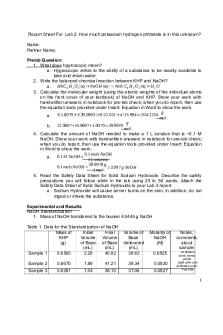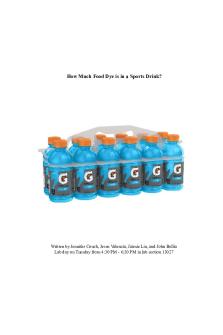Lab 2 report sheet How much potassium hydrogen phthalate is in this unknown PDF

| Title | Lab 2 report sheet How much potassium hydrogen phthalate is in this unknown |
|---|---|
| Author | Jacob Allen |
| Course | Quantitative Analytical Chemistry Laboratory |
| Institution | Kennesaw State University |
| Pages | 3 |
| File Size | 129.4 KB |
| File Type | |
| Total Downloads | 45 |
| Total Views | 124 |
Summary
lab report...
Description
Report Sheet For Lab 2: How much potassium hydrogen phthalate is in this unknown? Name: Partner Name: Prelab Question: 1. What does hygroscopic mean? a. Hygroscopic refers to the ability of a substance to be readily available to take and retain water. 2. Write the balanced chemical reaction between KHP and NaOH? a. HKC 8 H 4 O 4 ( aq ) +NaOH (aq ) → NaK C8 H 4 O 4 ( aq )+ H 2 O 3. Calculate the molecular weight (using the atomic weights of the individual atoms on the front cover of your textbook) of NaOH and KHP. Show your work with handwritten answers in notebook for pre-lab check; when you do report, then use the equation tools provided under Insert: Equation in Word to show the work. g a. 5 ( 1.0079 )+1( 39.0983 )+8 (12.011 )+ 4 ( 15.994 )=204.2234 mol g b. 22.9897 + 15.9897 + 1.0079 =39.9970 mol 4. Calculate the amount of NaOH needed to make a 1 L solution that is ~0.1 M NaOH. Show your work with handwritten answers in notebook for pre-lab check; when you do report, then use the equation tools provided under Insert: Equation in Word to show the work. 0.1 mols NaOH a. 0.1 M NaOH= 1 L solution 39.9970 g 0.1 mols NaOH × =3.997 g NaOH 1 mol 5. Read the Safety Data Sheet for Solid Sodium Hydroxide. Describe the safety precautions you will follow while in the lab using 25 to 50 words. Attach the Safety Data Sheet of Solid Sodium Hydroxide to your Lab 3 report. a. Sodium Hydroxide will cause server burns on the skin, in addition, do not ingest or inhale the substance. Experimental and Results NaOH Standardization 1. Mass of NaOH transferred to the beaker 4.0445 g NaOH Table 1: Data for the Standardization of NaOH Mass of Initial Final KHP Volume Volume (g) of Base of Base (mL) (mL) Sample 1 0.6500 2.29 40.92
Volume of Base delievered (mL) 38.63
Molarity of NaOH (M)
Notes, comments about sample
0.0825
At titration point, turned purple Light pink color at titration point Fait Pink
Sample 2
0.6670
1.89
41.21
39.34
0.0830
Sample 3
0.6261
1.04
38.10
37.06
0.0827
1
2. Provide one sample calculation of the molarity of NaOH (use equation tools under Insert: Equation in Word): 0.6500 g KPH −3 =3.18 × 10 mols KPH a. 204.2 g 3.18 × 10−3 mol KPH =0.0825 M KPH 38.63 × 10−3 L 3. Use your calculator or Excel to find the average molarity of the NaOH solution and give the answer here: a. 0.0827 M KPH 4. Use your calculator or Excel to find the standard deviation of the molarity of the NaOH solution and give the answer here: a. 2.516 ×10−4 5. Using the correct number of significant figures, report the molarity and standard deviation of the NaOH solution and give the answer here: a. 0.0827 M ± 0.0002 Unknown Analysis: Use the average molarity of your NaOH for the calculations of your unknown. Table 2: Data for the Determination of %w/w of KHP in an Unknown Sample Volume of % w/w of Notes, Final Mass of Initial Unknown Base KHP in comments unknown Volume Volume Number delivered unknown of Base of Base about 518 (g) (mL) (mL) (mL) sample At titration Sample 1 0.9231 0.50 31.80 31.30 57.27% point, turned Sample 2
0.9262
0.40
30.10
29.70
54.16%
Sample 3
0.9101
1.00
29.80
28.80
53.45%
purple Light pink color at titration point Fait Pink
6. Provide one sample calculation of the % w/w of KHP in the unknown (use equation tools under Insert: Equation in Word): a. 0.0827 M NaOH ×0.03130 L=2.588 × 10−3 moles NaOH 204.2234 g 2.588 ×10−3 moles KPH × =0.5286 g KPH 1 mol KPH 0.5286 g KPH ×100=57.27 % 0.9231 g Uk 7. Use your calculator or Excel to find the average %w/w of the KHP in the unknown and give the answer here: a. 55.29% 8. Use your calculator or Excel to find the standard deviation of the %w/w of the KHP in the unknown and give the answer here: a. 0.954 9. Using the correct number of significant figures, report the %w/w and standard deviation of KHP in the unknown and give the answer here: a. 55.29% ± 0.9547 2
Po7st Lab Questions 1. Why was the NaOH not dissolved in a Volumetric Flask? a. We did not need to use the volumetric flask because we weren’t aiming to get a certain molarity, instead we used the amounts used to calculate the molarity and to standardize our solution. 2. What happened to the flask when you dissolved the NaOH in the beaker? a. The temperature of the beaker increased as we dissolved the sodium hydroxide, caused by a exothermic reaction. 3. What type of reaction occurs between NaOH and phenolphthalein? a. Sodium Hydroxide is a very strong base and reacts in an acid-base reaction with the phenolphthalein. 4. Why do you only add two drops of phenolphthalein? a. Two drops allow for the appropriate color change to happen. If a smaller of greater number of drops are added, the color may be altered at the equivalence point. 5. Were any samples not included in the calculation for molarity and if yes, why? a. We used the mole-to-mole ratio in the balanced equation to calculate the NaOH solution’s molarity. This is because NaOH is hydroscopic. 6. Were any samples not included in the calculation for %w/w and if yes, why? a. All samples were used to calculate the %w/w because we needed the mass of unknown to get the final percent. We used the initial and final volumes to calculate how much NaOH was delivered into the system at the equivalence point. 7. Explain the chemistry occurring during the titration and at the endpoint. This should be in paragraph form and contain 50 – 70 words. a. During a titration, we are using a pH color indicator to see when the equivalence point is met. To do this process, you load a buret with Sodium Hydroxide base and then added an unknown amount of Potassium Hydrogen Phthalate (KHP). We added pH color indicator to show at exactly what point to stop the buret and conclude the reaction. Based on the amount of base delivered, we can calculate how much KHP was in the unknown sample. Write a concluding statement indicating the %w/w of KHP in the unknown: We found that the unknown #518 had an average weight percentage of KPH found to be 55.29%. We used the numbers and data from our lab procedure to calculate the %w/w for each trial and used Excel to calculate an average and standard deviation.
3...
Similar Free PDFs

Unknown Bacteria Lab Report
- 5 Pages

(Sample) Unknown Lab Report
- 6 Pages

General unknown lab report
- 2 Pages

General unknown lab report
- 3 Pages

Unknown Bacteria lab report
- 5 Pages

CMB Unknown Lab Report
- 5 Pages

Lab Sheet 2 - lab report
- 16 Pages

DC Circuit - this is a lab report
- 14 Pages
Popular Institutions
- Tinajero National High School - Annex
- Politeknik Caltex Riau
- Yokohama City University
- SGT University
- University of Al-Qadisiyah
- Divine Word College of Vigan
- Techniek College Rotterdam
- Universidade de Santiago
- Universiti Teknologi MARA Cawangan Johor Kampus Pasir Gudang
- Poltekkes Kemenkes Yogyakarta
- Baguio City National High School
- Colegio san marcos
- preparatoria uno
- Centro de Bachillerato Tecnológico Industrial y de Servicios No. 107
- Dalian Maritime University
- Quang Trung Secondary School
- Colegio Tecnológico en Informática
- Corporación Regional de Educación Superior
- Grupo CEDVA
- Dar Al Uloom University
- Centro de Estudios Preuniversitarios de la Universidad Nacional de Ingeniería
- 上智大学
- Aakash International School, Nuna Majara
- San Felipe Neri Catholic School
- Kang Chiao International School - New Taipei City
- Misamis Occidental National High School
- Institución Educativa Escuela Normal Juan Ladrilleros
- Kolehiyo ng Pantukan
- Batanes State College
- Instituto Continental
- Sekolah Menengah Kejuruan Kesehatan Kaltara (Tarakan)
- Colegio de La Inmaculada Concepcion - Cebu







